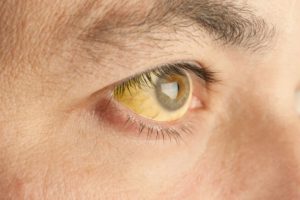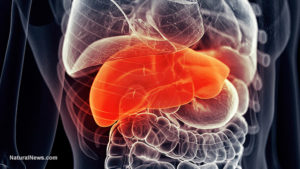 Liver damage is becoming more and more common in America. Fortunately, the damage presents some telltale symptoms.
Liver damage is becoming more and more common in America. Fortunately, the damage presents some telltale symptoms.
“Liver damage” encompasses a wide variety of liver problems.
In rare cases, liver damage can be a result of genetics. Wilson’s disease, for instance, is a rare genetic condition that results in the buildup of copper in the vital organs, including the liver.
Lifestyle choices, though, are the most common cause of liver damage. For some time now, liver disease has been associated with excessive drinking and hepatitis. More, recently, however, fatty liver disease caused by obesity, not drinking, has risen as the leading cause of liver damage in the United States. It is believed that as much as 30 percent of the western world has non-alcoholic fatty liver disease (NAFLD), according to research published by the World Journal of Hepatology.
Children also experience liver damage. Obesity rates in children have made an alarming jump in the western world, and the health complications that come with that are worrisome. In 2010, it was estimated that as much as 9.6 percent of children in the United States have NAFLD, according to research published in the journal Hepatology.
 Risk Factors for Liver Damage
Risk Factors for Liver Damage
There are certain things that can put you at further risk for liver damage. For starters, if either of your parents have genetic liver conditions, you are definitely at risk. But again, these conditions are very rare in the general population. Wilson’s disease, for instance, is believed to exist in one out of every 30,000 individuals, according to research published in the journal GeneReviews. If you know that this condition runs in your family, it’s best to consult your doctor.
Outside of genetics, lifestyle choices can play a huge role in putting a person at risk of developing liver damage. For starters, heavy drinking is a huge risk factor for the development of liver damage. Regularly drinking or binge drinking can result in three different kinds of liver damage: fatty liver, alcoholic hepatitis, and cirrhosis.
Fatty liver is experienced by most people who drink heavily, and it is characterized by fat accumulation in liver cells, according to the American Liver Foundation. Roughly 35 percent of heavy drinkers will also develop alcoholic hepatitis: swelling and damage of liver cells caused by excessive drinking. Individuals who have been drinking heavily for ten years or more are at risk of developing cirrhosis, which is the development of scar tissue in the liver. This disease is experienced by 10 to 20 percent of heavy drinkers.
“The other cause of liver damage that is slowly becoming the common cause in the United States is related to obesity and fatty liver disease,” explains Anton Bilchik, MD, PhD, the chief of gastrointestinal research at the John Wayne Cancer Institute in Santa Monica, California.
The prevalence of liver damage has risen significantly as the obesity rates in the United States have risen. In the United States alone, one out of every four individuals have fatty liver disease. Having diabetes and high cholesterol are risk factors for developing NAFLD, according to the American Liver Foundation.
 Acetaminophen, the common over-the-counter pain reliever (brand name Tylenol) and active ingredient in many prescription pain medications, can cause liver damage if taken irresponsibly. The U.S. Food & Drug Administration (FDA) considers acetaminophen-containing medications safe when taken as directed, but they warn that it can cause serious liver damage if over-consumed. For those who drink regularly or have preexisting liver disease, the FDA wrote, “taking acetaminophen puts you at greater risk of getting liver damage, even when taking acetaminophen at the recommended dose.”
Acetaminophen, the common over-the-counter pain reliever (brand name Tylenol) and active ingredient in many prescription pain medications, can cause liver damage if taken irresponsibly. The U.S. Food & Drug Administration (FDA) considers acetaminophen-containing medications safe when taken as directed, but they warn that it can cause serious liver damage if over-consumed. For those who drink regularly or have preexisting liver disease, the FDA wrote, “taking acetaminophen puts you at greater risk of getting liver damage, even when taking acetaminophen at the recommended dose.”
Lastly, baby boomers are also at risk for liver damage caused by hepatitis C, according to the Centers for Disease Control and Prevention. There is actually a fivefold increase in the risk of hepatitis C in this generation. Since many people have hepatitis C without knowing it, it’s generally recommended that anyone born between the years of 1945 and 1965 be tested. There are effective medical treatments for hepatitis C, which can prevent development of further complications, like “liver damage, cirrhosis, and even liver cancer.”
The Signs of Liver Damage
In the early stages, liver damage is often discovered in the doctor’s office, according to Tyson Collazo, MD, an assistant professor of medicine at Stony Brook School of Medicine. Through routine physicals or thorough testing in at-risk populations, many people discover the development of liver damage long before they notice their symptoms.
“You know, when physicians look at liver damage, they’re often finding things on routine blood work or they’ll order some liver tests and then find that things are just mildly abnormal,” says Collazo. “Usually people like that will have no symptoms at all.”
That being said, it is never a bad idea to know what to look out for. There are symptoms that can pop up as the damage progresses, so those who are at most at risk should watch for signs. The symptoms of liver damage are often subtle, but they are also unique. Here’s what you should be looking for:
Yellowed Skin
Your liver’s job includes breaking down old red blood cells. This process creates bilirubin, a yellow-orange substance in your blood, which your liver then stabilizes. But if the liver is damaged, it may not metabolize bilirubin properly, and this causes jaundice, or the yellowing of the skin.
 Yellowed Whites of Eyes
Yellowed Whites of Eyes
“Before people get this … yellow discoloration of the skin … the whites of the eyes get a yellowish discoloration,” explains Collazo. “That’s probably one of the majors signs of some liver damage going on.”
Yellowing of the whites of the eyes is also caused by the presence of bilirubin. It’s just one more sign that the liver isn’t able to do its job properly.
 Extreme Fatigue
Extreme Fatigue
Excessive fatigue can be a symptom of a damaged liver, according to Bilchik. If you are are dealing with unexplained exhaustion and you’re a part of a population who is at risk for liver disease, it might be time to talk your doctor about your symptoms.
Swelling
“When the liver is not working properly, it tends to push fluid out into the abdomen and into the legs,” explains Bilchik.
Excess fluid in the body is called edema when it’s experienced in the limbs and ascites when it occurs in the abdomen. The accumulation of this fluid can cause noticeable swelling in the trunk of the body, legs, and ankles.
 Itchiness
Itchiness
One lesser known symptom of liver damage is itchy skin, which is medically referred to as pruritus. What sets this symptom apart from dry skin is that it is experienced all over the body. In an interview with Gastroenterologist & Hepatology, Nora V. Bergasa, MD, described the situation: “Cholestasis is defined as impaired secretion of bile. It is a complication of almost all types of liver diseases, in both acute and chronic phases,” she said.
“Pruritus is defined as an unpleasant sensation that triggers the need to scratch. Chronic pruritus, or itch, is one of the most common symptoms associated with cholestasis.”
The chemicals that make you itch are created in the liver and excreted through bile, so when liver damage prevents bile from being processed, those itch-inducing components spread through your body in bodily fluids like plasma.
 “Pruritus can be the first manifestation of cholestatic liver disease,” said Bergasa, “and can precede the diagnosis of liver disease by years.”
“Pruritus can be the first manifestation of cholestatic liver disease,” said Bergasa, “and can precede the diagnosis of liver disease by years.”
Pain in the Right Side of Your Abdomen
Some liver damage has an acute onset, meaning it happens pretty quickly, according to Collazo. This type of liver damage is more likely to come with noticeable pain on the right side of the abdomen than liver damage that has slowly progressed over time.
 Difficulty Sleeping
Difficulty Sleeping
People experiencing liver damage my struggle to sleep well. However, since this is a symptom so commonly associated with more common health concerns and typically only develops in those who have already been experiencing liver problems, Collazo does not see it as a good sole indicator of liver damage. If noticed in conjunction with any of the above symptoms, though, difficulty sleeping could be a result of a damaged liver.
Prevention of Liver Damage
Depending on the extent of the damage, liver damage can be difficult to treat. For instance, there is no medication that address NAFLD. However, the risk factors for liver disease can be addressed through prevention. The most effective way to prevent liver damage is by making changes to your lifestyle and addressing any underlying health conditions that may cause liver damage.
The aforementioned hepatitis C, one of the major causes of damage, is treatable, so it is important to be tested if you are a part of the at-risk population so that you can be prescribed the appropriate medication.
Lifestyle changes, despite being incredibly difficult to make, can make a huge difference in the future of your health.
“Liver damage caused by hepatitis, cirrhosis, or obesity can all lead to liver cancer,” explains Bilchik. “And those [diseases] of the liver can be prevented through better nutrition and physical exercise.”
Those who are struggling with alcoholism need to give up drinking or learn to drink in moderation to mitigate their risk of liver damage. In many cases, this might require outside help like rehabilitation or joining a support group.
For those who are concerned about the risks of living with obesity, start by talking with your doctor. They can recommend lifestyle changes and set you up with specialized practitioners, like nutritionists, who can help you lower your risk of liver damage through healthy living.
Ultimately, anyone who has concerns about the health of their liver should be seeing a doctor right away. Liver damage can be very serious, and even fatal, if it is allowed to develop without intervention.
Written by Mary Sauer for Healthy Way ~ March 21, 2018.
The information posted above is NOT intended to replace a one-on-one relationship with a qualified health care professional and are not intended as medical advice.
 FAIR USE NOTICE: This site contains copyrighted material the use of which has not always been specifically authorized by the copyright owner. We are making such material available in our efforts to advance understanding of environmental, political, human rights, economic, democracy, scientific, and social justice issues, etc. We believe this constitutes a ‘fair use’ of any such copyrighted material as provided for in section 107 of the US Copyright Law. In accordance with Title 17 U. S. C. Section 107, the material on this site is distributed without profit to those who have expressed a prior interest in receiving the included information for research and educational purposes. For more information go to: http://www.law.cornell.edu/uscode/17/107.shtml“
FAIR USE NOTICE: This site contains copyrighted material the use of which has not always been specifically authorized by the copyright owner. We are making such material available in our efforts to advance understanding of environmental, political, human rights, economic, democracy, scientific, and social justice issues, etc. We believe this constitutes a ‘fair use’ of any such copyrighted material as provided for in section 107 of the US Copyright Law. In accordance with Title 17 U. S. C. Section 107, the material on this site is distributed without profit to those who have expressed a prior interest in receiving the included information for research and educational purposes. For more information go to: http://www.law.cornell.edu/uscode/17/107.shtml“
